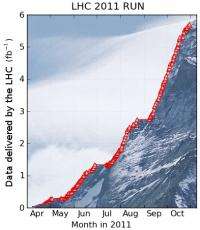CMS in 2011: A mountain of particle collision data

Datasets are the currency of physics. As data accumulate, measurement uncertainty ranges shrink, increasing the potential for discoveries and making non-observations more stringent, with more far-reaching consequences. In collider experiments, the amount of data is measured by the total number of collisions observed and the rate of those collisions, called the luminosity. In 2011, the Large Hadron Collider (LHC) produced more collisions than scientists dared to expect, breaking the world record luminosity in April and then continuing to grow seven-fold. By the end of the proton collision run in November, 240 million protons were colliding each second.
All of the experiments collecting data at the LHC kept pace with the torrent and produced some breathtaking results. Perusing just the publications of CMS (the experiment to which I belong) can give a flavor of the year's accomplishments.
The first LHC data allowed physicists to “rediscover” the spectrum of known particles, but now enough data are available to measure their properties with state-of-the-art precision. Top quarks, once considered rare, were produced at a rate of one pair every two seconds. The new dataset improves our understanding of the way protons collide and sharpens theoretical predictions of new phenomena.
One of the most sought-after results in collider physics is evidence of supersymmetry. This is the idea that matter and forces were unified in the early universe. Although this symmetry principle may appear in many guises, CMS scientists cast a wide net of search strategies to look for signs of supersymmetric particles. None were observed so far, and therefore many models that had been considered in 2010 are now ruled out. However, many more models with supersymmetry are still possible, waiting to be tested with larger datasets.
Many other models of new phenomena were studied as well, including extra dimensions, substructure within familiar quarks and leptons, excited variants, new generations, and conglomerates of these particles, new forces, new long-lived or stable particles, and even microscopic black holes. In each case, the fact that these phenomena did not appear imposes tighter limits on their existence, rolling back the scope of speculation with hard facts. For example, curled-up extra dimensions may exist, but if so, they must be curled 2.5 times smaller than previously supposed.
The last four weeks of the LHC run were dedicated to collisions of lead ions and physics of an entirely different character. When lead ions collide, so many quarks and gluons are produced that the fireball forms a fluid like the one that existed in the early universe. Three experiments at the LHC— ALICE, CMS, and ATLAS— witnessed the formation of this new state of matter. Data from 2010 revealed that the fluid is strongly interacting, has very little viscosity, can absorb most of the energy of extremely fast quarks and gluons, and that it is hot enough to melt mesons. It is too soon to say what will be found in this year's lead ion dataset, which is about 20 times larger.
The most dramatic revelation of 2011 concerns the Higgs boson, the as-yet undiscovered cornerstone of the Standard Model of particle physics. Hundreds of CMS physicists have pooled their data to show that the Standard Model Higgs, if it exists, can only have a mass in the narrow range between 115 and 127 GeV. ATLAS physicists set a very similar limit. This could mean that the Higgs is hiding within this range, that the real Higgs boson is not a Standard Model Higgs but has exotic properties, or that it simply does not exist. LHC scientists anticipate a large enough dataset in 2012 to make a definitive statement. Regardless of the outcome, the stage is set for an exciting year.
More information: Jim Pivarski is a freelance writer with a personal blog at www.coffeeshopphysics.com. This article was originally published in Fermilab Today.
Source: Fermilab



















